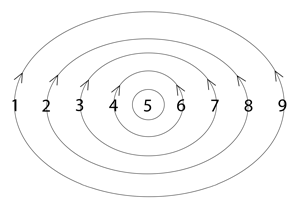individuate ideas
6-6-3
Conventional Understanding
In traditional understanding, “individuating ideas” refers to the cognitive process of distinguishing specific concepts from general knowledge. Conventional perspectives frame this process as humans actively creating ideas through mental effort, with education and business treating idea formation as acts of individual genius or ownership. This approach assumes ideas are objects we create and control, reinforcing separation between thinker and thought. Such assumptions lead to practices like aggressive intellectual property protection and competitive innovation rather than collaborative emergence.
Resonant Understanding
Word Cosmology reveals “individuate ideas” carrying a 6-6-3 resonance pattern, reflecting the completion point of the generative phase of creation. Like a prism revealing colors already present in white light, humans don’t create ideas but serve as focal points where universal potential becomes distinct. This challenges our belief that we author ideas, suggesting instead that we participate in a field where ideas naturally differentiate through us when we align with their patterns. “Eureka moments” demonstrate this—ideas often arrive fully formed when we stop forcing the process and allow natural differentiation to occur.
Expressions Spectrum Analysis
In balanced expression, this resonance pattern appears as “knowing,” “integrated information,” “experiencing,” and “clear,” showing how the natural flow of idea individuation feels like discovery rather than invention. When humans align with this balanced expression, they recognize themselves as focal points where creative potential naturally differentiates, neither claiming ownership nor rejecting responsibility. This balanced state allows ideas to individuate through human awareness without distortion.
When over-modulated, expressions include “fear,” “security,” “chastise,” and “strategic,” revealing how control and attachment distort the natural individuation process. These expressions demonstrate how humans might grip ideas too tightly, claiming ownership and fearing loss of control. This appears when we demand ideas conform to our expectations, forcing them through intellectual frameworks rather than allowing their natural unfolding. The expressions “profit” and “cost” highlight how commercialization can transform the natural differentiation into competitive commodities.
Under-modulated expressions such as “fear,” “security,” “confuse,” and “discourage” demonstrate disconnection from the natural individuation process. These reveal how humans might withdraw from their role in allowing ideas to become distinct, doubting their participation in the creative process. “I am not good enough” exemplifies this under-modulation, showing how self-doubt interrupts the natural flow by positioning the human as inadequate rather than as its natural focal point.
Russell’s Cosmogony Connection
Walter Russell’s cosmogony illuminates the 6-6-3 pattern through his description of thought formation. In “The New Concept of the Universe,” Russell writes: “When man creates thought forms for his ideas, his conception expands from the zero point of its beginning. He builds a complete mental three-dimensional form for his idea and creates a body to simulate that idea. He then fatigues from thinking that idea and rests for an interval before again thinking it into further form. The thoughts which he extends to cause body forms to appear he now retracts and they disappear.”
This passage reveals how idea individuation follows a rhythmic pattern of expansion and contraction, with humans participating in a pulsing cycle rather than creating in isolation. Russell’s description of conception expanding “from the zero point of its beginning” aligns with understanding that ideas don’t originate within humans but individuate through them from a unified field. The 6-6-3 pattern reflects this threshold where ideas become distinct enough to be recognized but haven’t yet fully manifested—precisely where “mental three-dimensional form” emerges but precedes the full “body to simulate that idea.”
Practical Implications
Understanding “individuate ideas” as a resonance pattern expressing through humans transforms our relationship with creativity. Instead of struggling to generate ideas through intellectual force, we can align with practices that allow natural differentiation—meditation, receptive observation, and creating conditions where ideas can emerge without excessive attachment or resistance. This perspective invites balancing active investigation with receptive awareness.
This understanding challenges narratives about intellectual property and creative ownership. When we recognize ideas as patterns emerging through humans rather than being created by them, we shift toward collaborative approaches where shared development becomes natural. Practices like open-source development and creative commons licensing align with this understanding, reflecting how ideas naturally flow through multiple focal points rather than belonging to individuals.
In daily life, this perspective liberates us from both the pressure of having to generate ideas and the limitation of believing we can’t access them. By recognizing ourselves as natural focal points where creative potential becomes distinct, we can approach challenges with confidence that solutions will naturally individuate through us when we align with rather than force the process. This honors our essential role in the creative sequence—not as separate creators but as the necessary threshold where potential becomes recognizable form.


